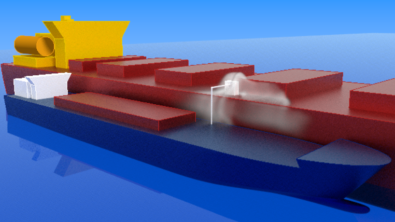Let’s break the cryogenic ice between you and LNG simulation

We are on July 15th. What a sunny day here in Plymouth, UK!
During such a day, half of the total country energy is supplied by renewable energy, fantastic progress has been done from the past last decade.
Suddenly, a droplet in my cocktail. It starts to rain. Not surprising. As we say: “every day is a sunny day in Plymouth, even several times a day.” But what about the energy split during such a rainy day, or during the night?
Well, in this case, most of the energy is still supplied by gas-fired power stations over the country and therefore Dr. Ian Cowan, Technical Director at Atkins, thinks that Liquified Natural Gas (LNG) will play an important role in the energy split in the next decade.

LNG transportation and associated challenges
So how do we get the gas from regions like Qatar or Australia to all customer developing countries? Over large distances, Natural Gas is most economically efficient once Liquefied. To convert it to fluid, you need to cool it down to -162degC, which involves significant cryogenic cooling system. This is where Dr. Ian Cowan, as its Computational Fluid Dynamics (CFD) expertise plays a role as you will better understand watching Siemens on-demand webinar about the modeling of cryogenic spills in the LNG plant.
Indeed, this is tempting to think LNG is another hydrocarbon liquid, but it brings a lot of specific modeling challenges and design constraints. For example, the physics of a leak, that could happen on an LNG plant, is quite complex. As you can see in the illustration below, the stream is actually composed by droplets that evaporate due to warm air. Very little drains out. Vapor is extremely cold, forming a kind of white fog our cloud dispersive on the ground, which might damage the structure of the environment, like brittle fracture of the carbon steel structure.

In this webinar, Atkins is introducing how they support the Oil & Gas industry with plant safety assessment, as well as people safety. From the understanding of an LNG leak behavior to visibility threat prediction, as well as intervention planning support. What tools are available to answer these challenges? The test campaign is extremely expensive and so extremely rare. This is where simulation comes into the loop.
Simple constant tools, running quickly, could reproduce fluid dynamics, but not as in reality where, as mentioned complex physics is involved. No adapted tool can reach to poor design with over secured modeling and so design assumption, excessive protection, safety measure, unneeded adding cost to the project, or worst not enough protection.

Atkins “found Simcenter STAR-CCM+ has helped” them “on a cross range of project to gain understanding on where the cryogen goes and how we can collect large liquid spills, and how to manage those”.
Safety first
Liquefaction is undertaken through several stages of cooling using simple refrigerating cycle, like several refrigerator home devices. Using heat exchangers between liquid and gas. The important note is that the refrigerant is a mixture of hydrocarbon, ethane, methane, propane, etc. so the LNG plant safety is linked with this complex refrigerant cycle.
In safety study, Atkins is focusing first on the understanding of a possible leak function of the involved fluids and the operating conditions (pressure and temperature) as simulation assumption will highly depend on this understanding. Function of these operating conditions, LNG leak might take the form of a liquid jet which will atomize in droplets or a vapor jet. Same for refrigerant which might come out as vapor or a flashing liquid.
Understand the fluid mixture and their phases will support the simulation assumption definition and so the correct software to be used to be sure all these assumptions are well considered. And Atkins really found the correct complexity to model reality thanks to Simcenter STAR-CCM+ CFD capabilities.
Moreover, Simcenter STAR-CCM+ delivers efficient post-processing tools to develop reports on as examples:
-
- How much of the release mass flux is reaching a specific surface?
-
- How much of this release evaporates?
-
- Or again how fast the size of the droplets decreases and what are the fluid concentrations along with the release (Methane, Ethane, Propane)?
Another application covered during the webinar is the way Atkins can consider the interaction that happens when a jet goes through a congested module. For example, how this congestion will reduce jet penetration distance? Well, simulation brings a clearer understanding of the impact of the plant structure to better define an efficient solution for structure protection.
Thanks again to Dr. Ian Cowan for his presentation. For more insight on how Simcenter portfolio can support the Oil & Gas industry, please visit our website or have a look at additional on-demand webinars.
Watch the webinar to learn how digital twins helps oil and gas companies to predict and perfect the performance of their subsea designs, throughout the lifetime of the asset.


